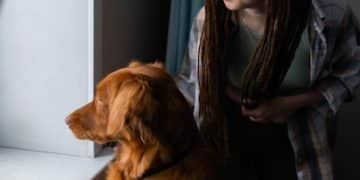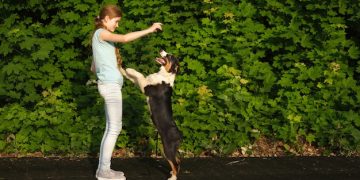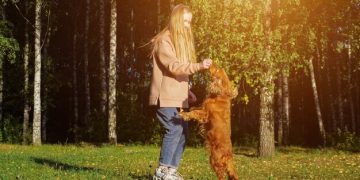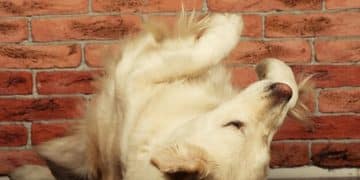Solve Jumping Problems: Train Your Dog in 2 Weeks
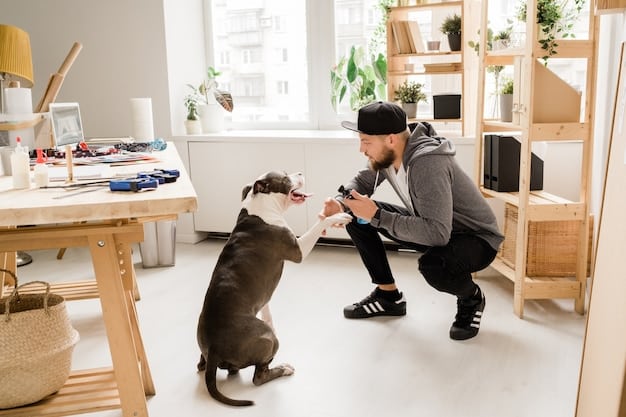
Solving jumping problems in dogs requires consistent training techniques, including rewarding calm behavior, using distractions, and teaching alternative greetings, which can effectively train your dog to greet guests politely within two weeks.
Is your dog’s enthusiastic greeting involving jumping on guests turning into a chaotic scene? Don’t worry, you can learn solving jumping problems and train your dog to greet guests politely in just two weeks with the right approach!
Understanding Why Dogs Jump
Before diving into the training techniques, it’s essential to understand why dogs jump in the first place. Often, it’s a display of excitement or an attempt to get attention.
Jumping is a natural behavior for dogs; it’s how puppies greet their mothers and littermates. However, it’s not a desirable behavior when directed towards people. Here’s a breakdown:
Excitement and Attention
Dogs often jump because they are excited to see you or a guest. This excitement translates into physical energy, which they release through jumping. Additionally, dogs quickly learn that jumping can elicit a response, even if it’s negative attention.
Dominance Myth
While older theories suggested jumping was a sign of dominance, modern understanding leans more towards attention-seeking and excitement. Dogs don’t necessarily jump to assert dominance but to get closer and interact.
- Seeking Attention: Jumping is a way for dogs to get eye contact and physical interaction.
- Learned Behavior: If jumping has been rewarded in the past (even unintentionally), the dog is likely to repeat the behavior.
- Lack of Training: Without proper training, dogs may not know how to appropriately express their excitement or seek attention.
Understanding these motivations is the first step in addressing the problem. By recognizing the reasons behind your dog’s jumping, you can tailor your training approach to be more effective.
In conclusion, dogs jump primarily out of excitement and a learned behavior to seek attention. By understanding these motivations, you can start to address the root cause of the problem.
Setting Up a Training Plan
A well-structured training plan is crucial for success. Consistency, patience, and positive reinforcement are key elements in modifying your dog’s behavior.
To effectively train your dog not to jump, follow these steps to create a comprehensive training plan:
Assess the Current Situation
Before starting, observe your dog’s jumping behavior. When does it happen most often? Who does your dog jump on? Understanding the triggers will help you tailor your training.
Establish Clear Goals
Define what you want your dog to do instead of jumping. For example, you might want your dog to sit calmly when someone enters the house or to keep all four paws on the ground.
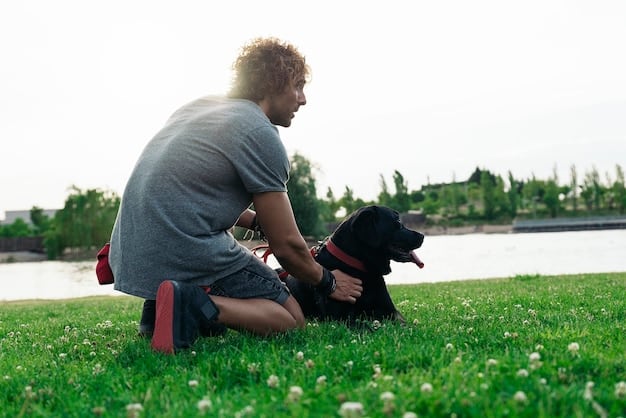
Two-Week Schedule
Here’s a sample two-week schedule to guide your training:
- Week 1: Focus on teaching alternative behaviors like sitting or staying. Practice these commands in various settings, including when people approach.
- Week 2: Introduce controlled scenarios with guests. Have friends or family members come over and follow your training protocol. Gradually increase the level of excitement and distractions.
- Daily Sessions: Keep training sessions short (5-10 minutes) and frequent. End each session on a positive note.
Creating a detailed training plan ensures that you stay consistent and focused on your goals. Following a structured approach will increase your chances of success in training your dog not to jump.
In summary, begin by assessing the current jumping behavior and set clear goals to achieve. With a well-defined two-week schedule, you can effectively train your dog to stop jumping on guests.
Teaching Alternative Behaviors
Instead of simply telling your dog not to jump, teach an alternative behavior that is incompatible with jumping, such as sitting or lying down. This gives your dog a clear action to perform.
Teaching your dog alternative behaviors provides a positive and constructive way to redirect their energy. Here’s how to implement this approach:
The “Sit” Command
The “sit” command is one of the most effective alternative behaviors. It’s easy to teach and provides a clear expectation for the dog. Plus, it makes jumping physically impossible.
Training Steps
Follow these steps to teach and reinforce the “sit” command:
- Lure with Treat: Hold a treat close to your dog’s nose and move it slightly over their head. As they follow the treat, they should naturally sit down.
- Verbal Cue: Say “sit” as they are moving into the sitting position.
- Reward: Immediately give the treat when their rear touches the ground.
- Repetition: Repeat this process several times a day in short sessions.
Generalization
Once your dog reliably sits in a quiet environment, start practicing in more challenging settings. Add distractions and vary the location to ensure they respond consistently.
By teaching and reinforcing alternative behaviors like sitting, you provide your dog with a clear and acceptable way to greet people. This positive redirection is key to solving jumping problems.
In conclusion, teaching alternative behaviors such as the “sit” command is a constructive approach to stopping your dog from jumping. This positive reinforcement method helps redirect their energy and provides a clear alternative behavior.

Managing Greetings with Guests
One of the most challenging scenarios is managing greetings when guests arrive. It’s important to set clear guidelines and ensure that everyone follows them consistently.
Managing greetings with guests requires coordination and consistency. Here’s how to handle these situations effectively:
Communicate with Guests
Before guests arrive, inform them that you are training your dog not to jump. Ask them to follow your instructions and avoid encouraging the behavior, even if it’s out of affection.
Controlled Entry
When guests arrive, keep your dog on a leash. Have them sit before the guest enters and reward them for staying calm. If the dog starts to jump, gently guide them back into a sit.
Ignore Jumping
If the dog jumps despite your efforts, instruct guests to turn away and ignore the behavior. Only give attention when all four paws are on the ground. This reinforces that jumping does not lead to interaction.
- Consistent Cues: Use the same verbal cues and commands with every greeting.
- Positive Reinforcement: Reward calm behavior immediately with treats and praise.
- Short Greetings: Keep initial greetings brief to prevent overstimulation.
By setting clear expectations and managing greetings with guests, you reinforce your training efforts and prevent your dog from reverting to jumping. Consistency is key to success.
In summary, managing greetings with guests involves clear communication, controlled entry, and consistent reinforcement. By ensuring everyone follows the same guidelines, you can effectively train your dog to greet people politely.
Using Positive Reinforcement Techniques
Positive reinforcement involves rewarding desired behaviors to encourage repetition. This method is more effective and humane than punishment, which can create fear and anxiety.
Positive reinforcement is a core principle in dog training. It focuses on rewarding good behavior to make it more likely to occur in the future.
Treats and Praise
The most common forms of positive reinforcement are treats and praise. Use high-value treats that your dog loves, but reserve them specifically for training sessions. Pair treats with enthusiastic praise to create a positive association.
Timing is Crucial
Reward the desired behavior immediately. Dogs have a short attention span, so the treat or praise must be given within a few seconds of the correct action. This helps them understand what they are being rewarded for.
Consistency is Key
Be consistent with your rewards. Always reward the desired behavior to reinforce it. Inconsistent reinforcement can confuse the dog and slow down the learning process.
- Variety of Rewards: Use different types of rewards, such as toys, petting, or verbal praise, to keep your dog engaged.
- Gradual Fading: As your dog becomes more consistent, gradually reduce the frequency of treats while continuing to offer praise.
- Avoid Punishment: Never use punishment or harsh corrections, as these can damage your relationship with your dog and lead to behavioral problems.
By consistently using positive reinforcement techniques, you create a positive learning environment that encourages your dog to repeat desired behaviors. This is crucial for solving jumping problems effectively.
In conclusion, positive reinforcement techniques such as treats, praise, and timely rewards are essential for successful dog training. Consistency and avoiding punishment ensure a positive learning experience for your dog.
Addressing Setbacks and Challenges
Training is not always linear; you may encounter setbacks and challenges along the way. It’s important to stay patient, adjust your approach, and not get discouraged.
Even with the best training plan, setbacks and challenges are inevitable. Knowing how to address these issues is crucial for long-term success.
Regression in Behavior
Sometimes, a dog that has been consistently performing well may suddenly regress. This can be due to various factors, such as stress, changes in routine, or inconsistent reinforcement. Identify the cause and adjust accordingly.
Adjusting Training
If your dog is struggling with a particular exercise, break it down into smaller, more manageable steps. Make sure your dog fully understands each step before moving on.
Professional Help
If you’re consistently facing challenges or your dog’s jumping behavior is severe, consider seeking help from a professional dog trainer or behaviorist. They can provide personalized guidance and address any underlying issues.
- Stay Positive: Keep training sessions positive and fun, even when faced with setbacks.
- Be Patient: Remember that training takes time and consistency. Don’t get discouraged by occasional slip-ups.
- Revisit Basics: Sometimes, going back to the basics and reinforcing fundamental commands can help address regression.
By addressing setbacks and challenges with patience and adaptability, you can ensure the long-term success of your dog’s training. Don’t hesitate to seek professional help if needed.
In summary, addressing setbacks in dog training requires patience, adaptability, and a positive attitude. By identifying and addressing the root causes of regression and seeking professional help when necessary, you can overcome challenges and achieve your training goals.
| Key Point | Brief Description |
|---|---|
| 🎉 Teach Alternative Behaviors | Replace jumping with behaviors like sitting or lying down. |
| 🏡 Manage Greetings with Guests | Communicate with guests and control the entry process. |
| 🐾 Consistent Positive Reinforcement | Reward desired behaviors consistently with treats and praise. |
| 🗓️ Establishing a Training Plan | Assess jumping behaviors and create a structured two-week schedule. |
Frequently Asked Questions
▼
With consistent training, you can see improvements in about two weeks. However, complete behavioral change can take several months, depending on the dog’s temperament and consistency of training.
▼
Dogs often jump on people they are most excited to see or those who inadvertently reinforce the behavior. This can be due to past interactions or the person’s body language.
▼
Keep your dog on a leash in these situations and maintain a safe distance. Ask the person to remain calm and avoid direct eye contact. Focus on redirecting your dog’s attention to you.
▼
You can designate specific times or places where jumping is allowed, such as during playtime or in a designated “jump zone.” This helps the dog understand when it’s acceptable and when it’s not.
▼
Control the environment by keeping your dog on a leash or in another room when guests arrive. Work on training in less distracting environments first, gradually introducing controlled interactions as the dog improves.
Conclusion
Solving your dog’s jumping problem requires a consistent, patient, and positive approach. By understanding the reasons behind the behavior, setting up a structured training plan, teaching alternative behaviors, and managing greetings effectively, you can successfully train your dog to greet guests politely and calmly in about two weeks.
